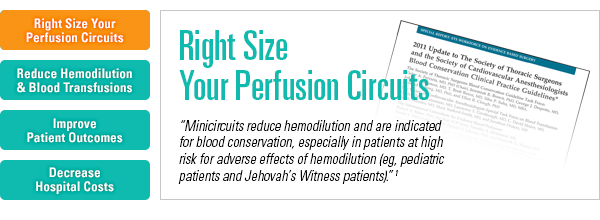...Use the Evidence to Point the Way


Prescriptive Oxygenation™ is Terumo's unique approach to helping perfusionists meet each patient's oxygenation and blood management needs more precisely.
Based on their body surface area, a significant number of patients would benefit from a smaller or mid-sized oxygenator designed to better match their actual metabolic needs all while decreasing hemodilution and other risks associated with cardiopulmonary bypass. Studies have shown that controlling hemodilution through lower prime volume circuits can result in fewer blood transfusions.5, 6, 7 That's why we offer you a choice of three different sizes within our proven CAPIOX line of oxygenators.
References:
- Ferraris, et al. 2011 Update to the Society of Thoracic Surgeons and the Society of Cardiovascular Anesthesiologists Blood Conservation Clinical Practice Guidelines. Ann Thorac Surg 2011; 91:944-982.
- Baker, R., et al. (2013). American Society of ExtraCorporeal Technology Standards and Guidelines For Perfusion Practice.
- Lahanas, T., et al. (2013). A retrospective comparison of blood transfusion requirements during cardiopulmonary bypass with two different small adult oxygenators. Perfusion. July 2013, 28 (4).
- Bronson, S., et al. Prescriptive Patient Extracorporeal Circuit and Oxygenator Sizing Reduces Hemodilution and Allogeneic Blood Product Transfusion during Adult Cardiac Surgery. JECT. 2013:45:167-72.
- Shann, et al. An evidence-based review of the practice of cardiopulmonary bypass in adults: A focus on neurologic injury, glycemic control, hemodilution, |and the inflammatory response. J Thorac Cardiovasc Surg 2006;
132:283-290. - Preston, et al. Clinical Gaseous Microemboli Assessment of an Oxygenator with Integral Arterial Filter in the Pediatric Population. JECT 2009; 41:226-230.
- Gomez, et al. Evaluation of air handling in a new generation neonatal oxygenator with integral arterial filter. Perfusion 2009; 24 (2)107-112.
Refer to this device’s Instructions For Use (IFU) for the risks associated with its use.


